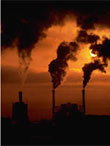Air pollution and temperature
variations affect child mortality
Washington, Aug 16 (ANI)
A Spanish study has revealed
that seasonal variations in death rates for young children are related to
high levels of particulate air pollution and cold temperatures during the
winter months, and to high levels of particulate pollutants and nitrogen dioxide during the summer months.
and nitrogen dioxide during the summer months.
Dr. J. DA-az of Universidad AutAnomo de Madrid along with other researchers
reviewed weather and pollution monitoring data for Madrid from 1986 through
1997.
The results published in this month's issue of Occupational and
Environmental Medicine, showed significant interactions between daily
temperatures and levels of specific air pollutants. In the wintertime, child
mortality rates rose a few days after cold days with high levels of
particulate air pollutants or total suspended particles (TSP). Death rates
increased dramatically after cold days with temperatures less than 43B0
Fahrenheit.
In summers, child mortality rates rose with levels of nitrogen oxide
pollutants. Most of the temperature and pollution-related increases in death
rates were limited to children between 1 and 5 years old.
The results provide new insights into how daily environmental conditions at
ground level might affect health in infants and young children. High TSP
levels is a hazard to children in both the winter and summer months, while
temperature is a factor mainly on cold days.